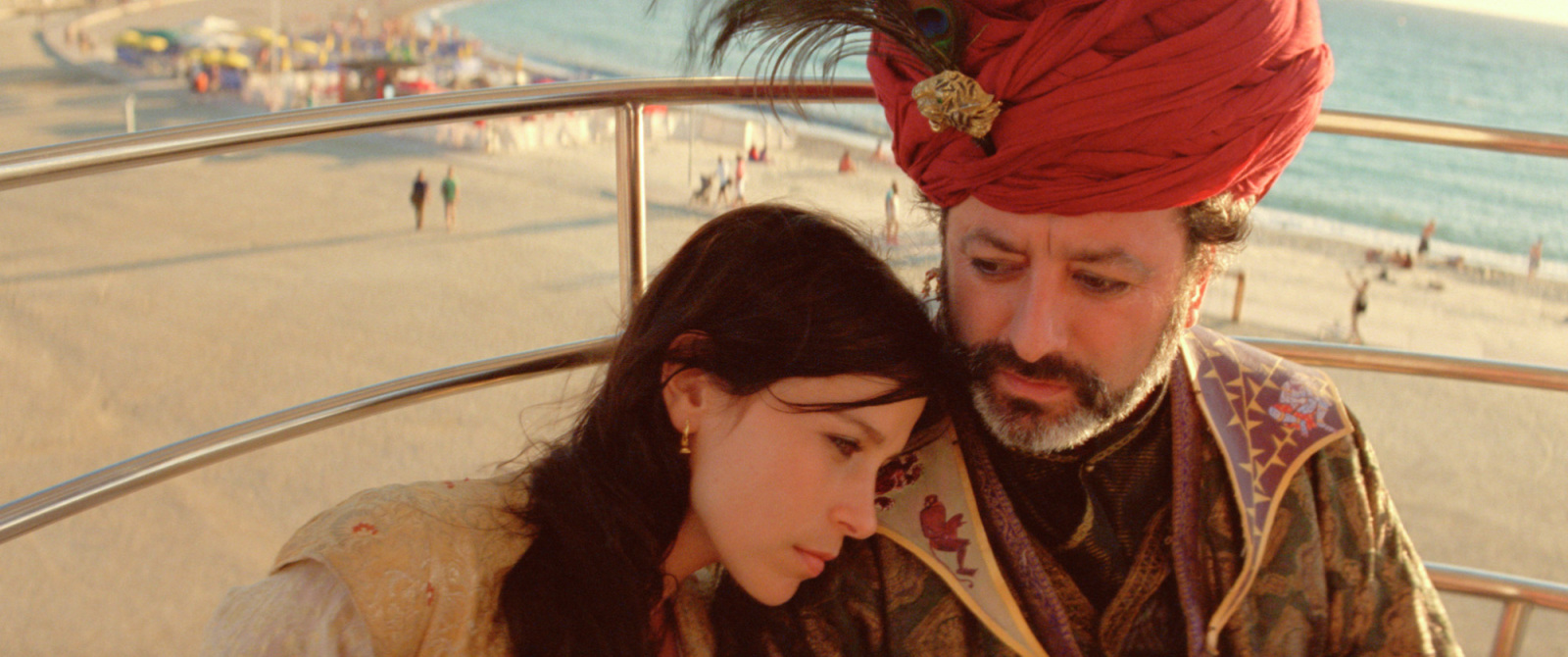Whenever I sit down to watch a movie at The New
York Film Festival (something I’ve been looking forward to for the last full
calendar year), I’ve noticed that it’s incredibly difficult to turn off my
brain to coincidence. I suppose it’s part of the job. NYFF is actually
comparatively light on movies compared to gauntlets like Toronto or Cannes, and
yet there are still over 50 fascinating films to choose from; an embarrassment
by any measure. The press screenings are thrown at critics in ways that seem so
random that there must be some secret order. Part 3 of a six-hour saga must
have something to do with a ponderous revisionist western, right? The search
for a theme can frequently lead me too far away from the films themselves, but
there’s no shaking the commonality. There are ideas that appear in film after
film like love letters you thought you’d thrown away suddenly falling out of
the back of a notebook.
It’s precisely that feeling, the choice
between remembering and forgetting, that ties together these two main slate
offerings, Miguel Gomes’ trifurcated “Arabian Nights” (covered in part by the
formidable Ben Kenigsberg at Cannes last May) and Thomas Bidegain’s “Les
Cowboys.” One is about the false comfort and inevitable bitterness of memory,
the other about the inestimable value and many uses of the same thing. A
cultural memory still being written binds the two tales of a family and a
country torn apart by tragedy. One is massive, the other small. One is funny
and free, the other closed off and humorless. One is about the beauty of the
simplest parts of culture and their mythic continuity with a past only
accessible through ritual, the other is terrified of all of that. The bad news
first, eh?

If you know Thomas Bidegain, it’s probably
as the scribe of most of Jacques Audiard’s work, but he finally makes his
directorial debut with ”Les Cowboys.”
As its name lamely and facilely suggests, this is an update of John Ford’s
western “The Searchers” but hews much closer to Paul Schrader’s porn-centered
tribute “Hardcore” than the genuine article. At a kind of annual
western/rodeo-themed county fair in one of the most beautiful parts of France,
a man loses his daughter. A day passes and the truth is revealed: she’s left
town with her Muslim boyfriend, and has no intention of coming back. So begins
a decades-long scouring of Europe and the Middle East for any shred of evidence
of the long-missing Kelly. It first consumes the father’s life and then his
son’s, who picks up where he left off after seeing the events of 9/11 on TV.
The film volleys back and forth between points of view before ultimately
deciding that not having one is more to its taste.
It’s rather telling when a
screenwriter/director decides that the way around an unsympathetic character is
either death or marriage to a sympathetic one. Not even the Levi’s-ad
cinematography can disguise the ugliness at the film’s core with relation to
its clueless protagonists (it never does). The film condemns revenge in a
roundabout sort of way, but not without the help of hideous Muslim stereotypes,
a literal white savior, and a bout of Stockholm syndrome that of course turns
into romance. The unavoidable truth is that, behind all the narrative
subterfuge, writer Noé Debré and Bidegain have nothing to say. The film has to
tie itself in knots that would shame a tantric masseuse to get to its
supposedly powerful conclusion, as Bidegain passes a thousand things more
interesting than the plot. A documentary about Americana-obsessed French cowboy
culture would have been fascinating, and he’s clearly interested in it, as
those sections are the strongest. Such a choice might have excused the
too-pretty photography, anyway.
In his review of Truffaut’s “Mississippi
Mermaid,” Stanley Kauffmann wrote of the French director’s relation to the
auteur theory: “One tenet … holds that
material is less important than its cinema treatment, thus these directors have
often taken stock material, like American thrillers, in order to prove that
film art can be made out of the film’s ‘own.’ Sometimes the transmutation
succeeds; more often, the result is only a combination of smugness and camp.”
There is no better way to describe “Les Cowboys,” an arthouse sham that will
make you reconsider other misfires that have used the war-on-terror as a
backdrop, like Brian De Palma’s “Redacted” and Bruno Dumont’s “Flandres.”

Miguel Gomes’ “Arabian Nights” has a completely different relationship to the
past, while still being fundamentally compelled by its sweet auspices. It was
instructive to see the World Cinema Foundation’s excellent restoration of
Filipino director Lino Brocka’s should-be-a-classic “Insiang” right after
“Arabian Nights.” “Insiang,” a neorealist plea for compassion dressed as a
torrid melodrama, allows the inhospitable living conditions of the people they
describe to seep in around the main action. Brocka couldn’t point a camera at a
starving child, too poor to afford clothes, and place the words, “This is what
the government has to answer for,” on-screen in bold type. He had to let facts
stroll by his fiction or risk looking like a dissident at a time when president
Ferdinand Marcos could have had him killed like so many of his other opponents.
Miguel Gomes is under no such restrictions. The Portuguese government will
probably do nothing to him for calling them incapable of social justice, as he
does at the start of each of the three parts of “Arabian Nights.” This leads to
an interesting question at the heart of the daring and dazzling project: Can
artists be said to represent a people? If that’s the case, do they have a
responsibility to do so through their art?
Gomes has always answered “yes” to that
question, but not without a little sideways glance and a grin. He’s Portugal’s
premiere Jean-Luc Godard enthusiast, a man who points his camera like a
telescope observing a parade. Here is the commemoration of an historic event.
Here a song and dance only known to the residents of one village. “Arabian
Nights” finds him in the meta-tastic mode of his breakthrough feature “Our
Beloved Month of August.” It is comprised of a dozen vignettes based around the
economic crisis in Portugal (specifically from 2013-2014) and how it affected
the citizenry.
Form and tone seem to be the guiding
principle behind the separation of the film into its disparate parts. “Volume
1: The Restless One,” true to its name, is texturally omnivorous, introducing
the structural conceit of the film after a very funny intro in which the crew
play themselves. Gomes wears many masks here. The opening mixes his existential
crisis (he says he has gone impotent as a director, an idea that will appear
again and again throughout the three parts) with the story of a dwindling wasp
colony and a strike at a ship yard. The interplay of image and sound and the
meshing of the three stories directly recalls Godard’s early veering into
non-fiction, 1968’s “A Film Like Any Other.” He manages, however, to
demonstrate an aesthetic tenderness that the Swiss legend was in the process of
abandoning at that time. “Volume 1” continues to weave together the gnostic and
the personal, the cinematic and the dully humane, the historic and the present,
fiction and non-fiction, with little apparent regard for the shape it takes.
That, unfortunately, will prove a
deal-breaker for a lot of people (as may his over-reliance on a handful of
fourth-wall breaking devices). The parts don’t have clean endings, so viewers
will naturally want to know what comes next; to see how Parts 2 and 3 will
speak to Part 1. This presents a slight problem. “Volume 2: The Desolate One”
adds new ideas and modes to the mix, but does not expressly comment on the
events of “Volume 1.” “Volume 3: The Enchanted One” abandons the promises of
both for an audaciously unhurried detour into a non-narrative cul-de-sac. The
solution, strange as it may sound, is to watch all three in a row. The ending
sequence, one of the best you’ll see all year, has power because it follows a
370-minute tour of a nation bleeding to death. This scene consists of a long
walk with a major, yet still slightly mysterious character in “Volume 3,” accompanied by The Langley Schools Music Project’s cover of Klaatu’s “Calling
Occupants of Interplanetary Craft.” That sounds hopelessly random, but it’s
unexpectedly and powerfully cathartic. The long minute Gomes grants you to
exhale after his little epic really only works if you’ve had the whole six
hours to build to it.

But I’m getting ahead of myself. “Volume
1’s” pleasures are in the way Gomes lets you know that he’s behind the camera.
The film’s biggest laugh belongs solely to him, as he sits next to his
co-writer, growing aware that he’s being filmed, and eventually running away
from his own movie. The crew rather touchingly gives chase. It’s a game, sure,
but Gomes plays with all his heart. This soon gives way to the framing device,
of Scheherazade on an island of women, dreaming up stories to tell her husband
the king to keep him from beheading her for the fabled 1,001 nights. Here the
film, moored in paradise, is most redolent of Gomes’ last triumph, 2012’s
“Tabu”, but it only stays a moment before diving into realizations of
Scheherazade stories. “Volume 1” is taken with a sarcastic punk rock humor that
works about 50% of the time and co-mingles news items and the logic of fables. “Volume
2: The Desolate One,” Portugal’s submission for the Oscar for Best Foreign
Language Film, is the verist, an overtly Buñuelian phase. First we spend time
with an outlaw who has unexpectedly become a hero during his time on the lam.
Then it’s off to a surreal trial where every testimony accidentally indicts
someone new, each party (from a genie to a talking cow to 10 Chinese
courtesans) miraculously appearing in the courtroom while Gomes pretends
they’ve been there all along. Finally we follow the fortune of a dog passed
from one poor tenement resident to another in search of stability. “Volume 3”
checks back in on Scheherazade, who, it becomes clear is meant to be the
personification of Portugal, in all her doomed glory. The film ends with a
documentary on a song bird competition that consumes the lives of many men.
Several of them have become obsessed with capturing the song of a generation of
birds who died in a tragic accident.
Look closely and you can see that every one
of these is a not-so-thinly veiled accusation, a purposeful rendering of a
bunch of news items related only in that they happened unfairly to an
impoverished class unable to change their fortune. The metaphors aren’t hard to
parse, so the question is: Does this smorgasbord form a coherent whole worth a
quarter of your day? Yes, yes, a thousand times yes. To return to the question
I posed earlier, if artists like Gomes (or Sergei Loznitsa or Aleksei
Fedorchenko or Jafar Panahi) won’t shoot films documenting the human cost of
greed and oppression in their home countries, foreign audiences will never
glimpse what life in these cultures looks like, what their value systems have
become, what they’re afraid of, and what they live with day in and day out.
Artistically the film justifies itself through routine displays of Gomes’
rhythms and imagination. “Arabian Nights” is a hybrid of about a dozen forms,
most importantly that of the song cycle. Motifs appear and reappear constantly,
buttressing the new chapters with an ever strengthening thematic identity. “Volume 1” in particular is like a road being paved and driven upon at once, with
text and subtext commenting on and redefining almost every image moments after
they’ve occurred. This can become blissfully insane, like the case of the whale
who swallowed a mermaid, a man’s endoscopy taking place in a giant stomach, a
judge who can speak the language of a rooster, or the arson with a fondness for
emoji. I realized during these bonkers little tangents that Gomes wanted me to
look for coincidences in this madness, because they make everything richer.
If this all sounds like too much to keep
track of, you’re getting at the dilemma that led to the project in the first
place. Gomes and his writers looked at the headlines a few times too many and
saw things that made their blood run cold. The government was pushing culture
underground, making ancient ritual, language, art and the people who practiced
them extinct. Like the songbird catchers, Gomes tried to quickly capture the
music of Portugal before it faded, no how obscure the tune. And that’s not just
metaphor: the film is bursting with robust music, each representative of the
subset of civilization in which the film’s pieces take place. Gomes used to
subtitle all of his early shorts “a musical comedy” and here, he has placed a
microphone to the heart of Portuguese history like a stethoscope and played
back the vibrant and varied songs he heard, intermingled with the music of his
coming of age in the Portugal that only he knows. What bolder and more
defiantly optimistic a response to tyranny than to release a full-throated song
about dozens of esoteric heritages that it would silence that lasts for six
hours? This ultimately is what makes “Arabian Nights” the can’t-miss film of
2015. It is a record of a human history told through the alternately sarcastic,
sincere and poetic voice of an uncompromisingly weird artist. Can we ask for
more? Even if you don’t fall head over heels in love with “Arabian Nights,” I
doubt very much that you’ll forget it.












